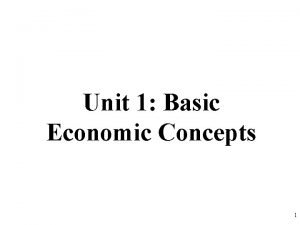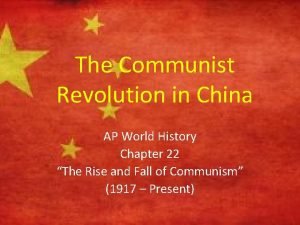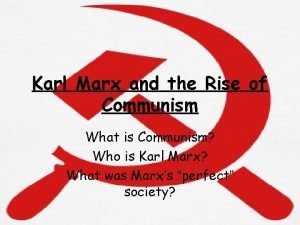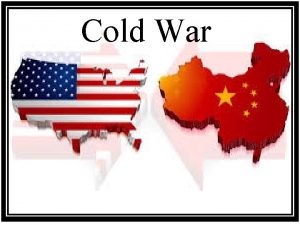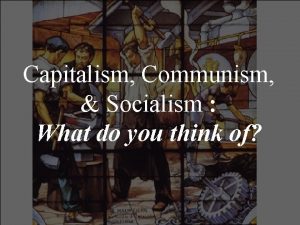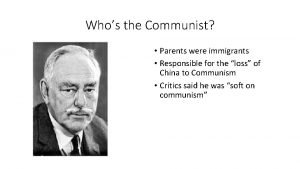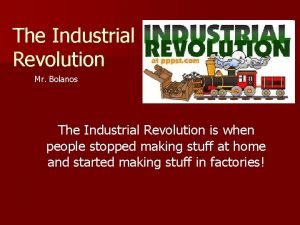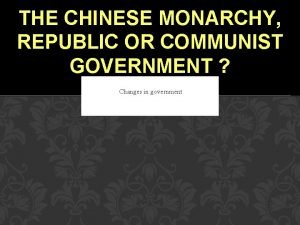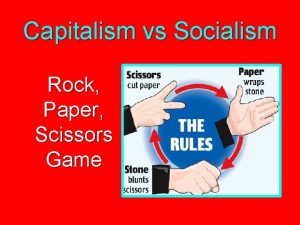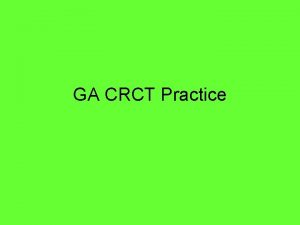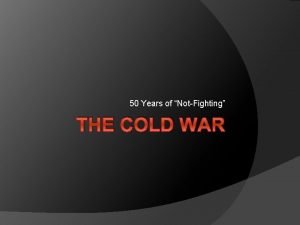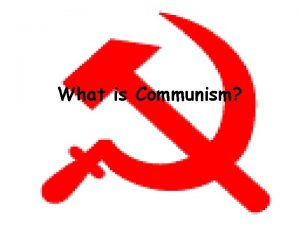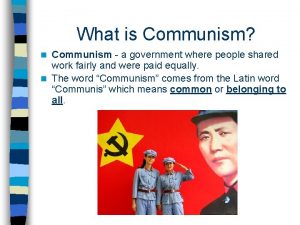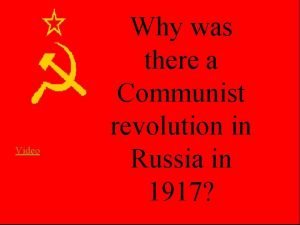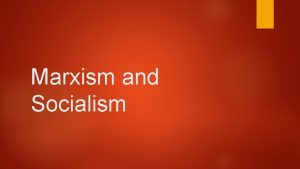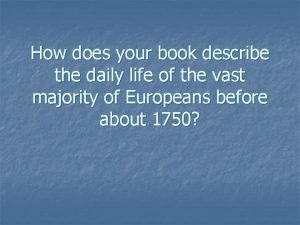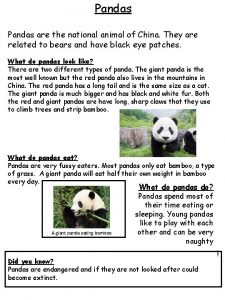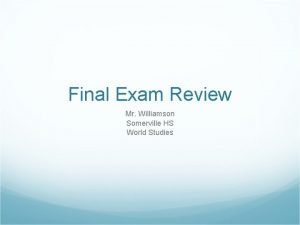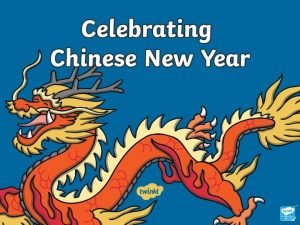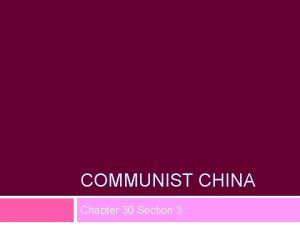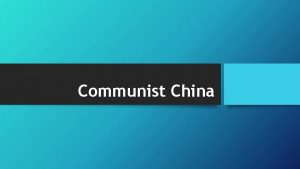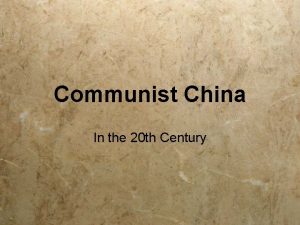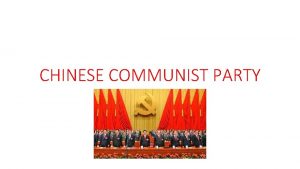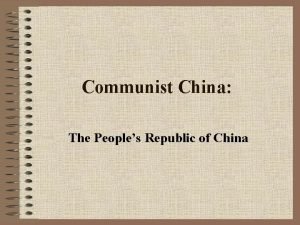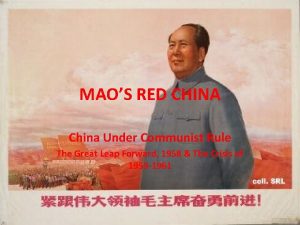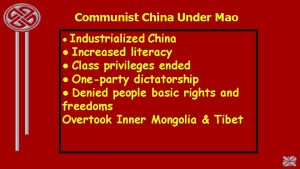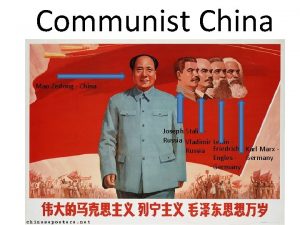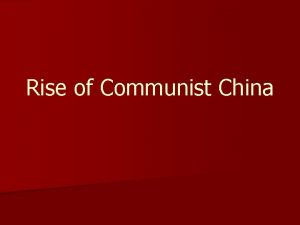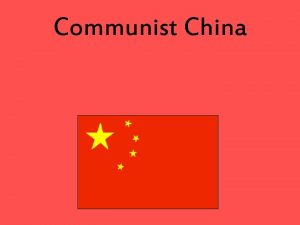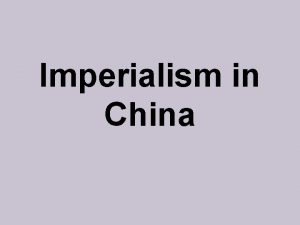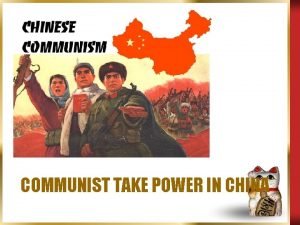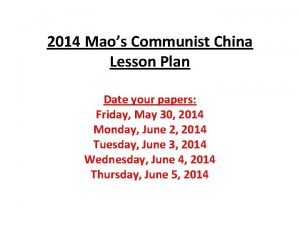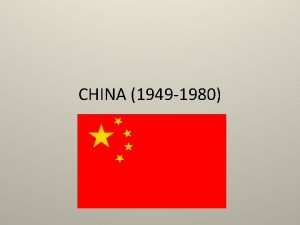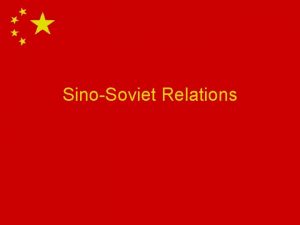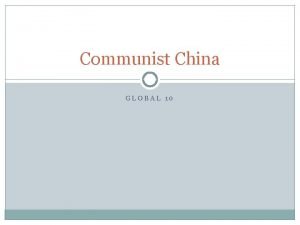CHINA Why China China is a capitalistic communist































- Slides: 31

CHINA


Why China? • China is a capitalistic communist country • It did a SINGLE TRANSITION…just economic— will it lead to political change? It always has… • Authoritarian, one party state • Most important economy in the world

Overview: The Big Picture • • • System of Government: Authoritarian Single Party Rule Distribution of Power: Unitary System Electoral System: Is there one? Authoritarian One Party Constitution: 1982 Legislature: Unicameral Current Head of Party and State: President Hu Jintao Head of Government: Prime Minister Wen Jiabao Current Ruling Party: Communist Party Major Political Parties: …. .

Things To Remember: • Communist China is only 60 years old…young • China has had 4000 years of authoritarian rule • Communism is a perfect fit for authoritarian historical tradition. • China is only half communist—politically • Economically China is a free market freak

Political Culture: The Chinese Mind Dynastic Rule for 4, 000 YEARS – Confucianism: Social harmony based appropriate behavior within hierarchy. Maoism 1949 – Strongly influenced by Marx and Lenin but his version of communism was distinctly Chinese – Whereas Lenin emphasized the importance of the party vanguard to lead people to revolution and beyond, Mao resisted the inequity implied by Lenin’s beliefs

Political Culture: The Chinese Mind • Collectivism – Valuing the good of the community above that of the individual • Egalitarianism – Hierarchy was the key organizing principle before 1949—Confucianism – Mao’s emphasis on creating an egalitarian society was in complete opposition to it • Self-Reliance – Instead of relying on the elite to give directions, people under Maoist rule were encouraged to rely on their own talents to contribute to their communities

Political Culture: The Chinese Mind Deng Xiaoping Theory 1978 -1997 – He didn’t worry too much about whether a policy was capitalist or socialist as long as it improved the economy. – So……as long as he (they) they stayed in power, so what…. – Ahh, so it’s all about power…imagine that from a politician. Mao Deng

Political Culture: The Chinese Mind Deng Xiaoping Theory 1978 -1997 – The result of his leadership was a dramatic turnaround of the Chinese economy through a combination of socialist planning and the capitalist free market – His political and social views remained true to communist tradition—the party should supervise all, and no allowance should be made for individual freedoms and/or democracy

CURRENT POLICY CHALLENGES • While economic liberalization has taken place, the government has firmly suppressed organized challenges to the Communist Party • Handful of leaders at the top monopolize the authority to choose what inputs from what groups are acceptable • The rules of the game are not transparent • Hong Kong—clashes over western oriented population who have enjoyed political rights • Taiwan—political unification • Non-Han minorities, such as the Tibetans, challenge Chinese nationalism

• Huge population SOCIAL CONDITIONS – World’s most populous country – Most live in the countryside, but now that is only 57% compared to 85% in 1980 – Rural industrialization and growth of towns – Rural collective industry is the most dynamic industrial sector • The population is concentrated in the eastern third of the land – Only ¼ of China’s land is arable – The problem of feeding the large population is expected to continue • China is a multiethnic state – 92 percent of Chinese are ethnically Han, but there are fifty-five recognized ethnic minorities, ranging in number from a few thousand to more than 16 million.

HISTORY OF PRC • At first China looked to Soviet Union for implementation strategy--FAILED • Soviet Like Structures – – Central bureaucracy of planning agencies Nationalized industry Built collective farms Tolerated no dissent once directives were articulated • Implemented many campaigns to mobilize the mass with compulsory participation • Hundred Flowers Campaign – Example of relaxation of control over dissent, only to be overturned • “Enemies of the state” declarations common and millions were imprisoned or killed • Chinese Soviet Split – 1950 s cooling off period between China and Soviet Union – partially due to Soviet unwillingness to help with Chinese nuclear program

THE GREAT LEAP FORWARD • Great Leap Forward (1958 -1966) was a utopian effort to transform China into a radical egalitarian society. MAINLY ECONOMIC! • Attempt by Mao to free China from Soviet domination • Campaign requested that citizens abandon material rewards and needs for moral reasons • FAILED: Mao’s efforts ran counter to the traditional political culture (bureaucratic centralism), and the people lacked the skills to contribute to industrialization • Failure Lead to Cultural Revolution

CULTURAL REVOLUTION • The Cultural Revolution (1966 -1976) was a much more profound reform in that it encompassed political and social change, as well as economic • Campaign driven by anti-Western rhetoric--Western material goods were destroyed (he found and enemy) • Citizens were tried for crime of being “capitalist roader” or siding with the West • All Chinese were forced to be involved • Schools were closed as youth were expected to join the movement • FAILED! By late 1960 s the citizens had taken the campaign to new height and the country neared anarchy • Mao died in 1976

CULTURAL REVOLUTION: AFTER • Mao died in 1976 • Deng Xiaoping Theory! – “It doesn’t matter of the cat is black or white, as long as it catches mice. ” – Retreated from Cultural Revolution – Changed the direction of economic policy in China – Allowed foreign investment (special economic zones) – Privatized industry – Relaxed some of political controls imposed by Mao

STRUCTURE OF THE PARTY STATE • “Parliamentary System under single party control” • “Nothing really matters but the party” • Design Features – The basis of the idea was that the party’s claim to legitimate rule is not based on representation of the preferences of the majority, but on representation of the “historical best interests” of all people—the idea being that the populace does not know its own best interest, but the party does…. isn’t that brilliant!

STRUCTURE OF THE PARTY-STATE – Party Organization • Democratic Centralism – Leninist principle – This means that democracy exists only at the center of decision making, but once a decision is made no dissent is tolerated. – Centralism never sacrificed to democracy • There are official government structures in China, but the real power lies with the party – Two Hierarchies, with Party Leadership • Government structures are more or less duplicated at each level of the political system by Communist Party structures • In principle, there is a division of labor between party and gov’t structures • In practice, two perform similar functions with overlapping responsibilities • But with the party being the main policymaker


GOVERNMENT STRUCTURES • National People’s Congress (NPC): Legislative Functions – Elected for five-year terms by delegates in provincial-level congresses and the armed forces – Assemble once annually for a plenary session of about two weeks – Always large body – Formally has extensive powers: amendment of the constitution, passage and amendment of legislation, approval of economic plans, etc. – Is it a rubber-stamp assembly? Was during Maoist years, but now…. – It is still too large and meets too infrequently, but the lawmaking role of the less cumbersome NPC Standing Committee seems to be gaining.

GOVERNMENT STRUCTURES • NPC Standing Committee – When NPC is not in session (almost all the time), the NPC Standing Committee serves as working legislative assembly – 150 members, all reside in Beijing – Meets regularly throughout year – Exercises most formal powers of NPC and prepares agenda for annual NPC plenary sessions.

GOVERNMENT STRUCTURES • State Council: Executive Functions – In lawmaking, State Council is center of gov’t activity – Composed the premier, who is head of government, and his cabinet of vice-premiers, state councilors, ministers, auditor general, and secretary general – State Council Standing Committee, which meets twice weekly – As in most parliamentary systems, the bulk of legislation is drafted by specialized ministries and commissions under the direction of the cabinet – President- Head of State – purely ceremonial office

GOVERNMENT STRUCTURES • Judiciary: – Supreme People’s Court – Supreme People’s Procuratorate • Bridge between public security agencies and the courts • Communist Party Leadership – The Communist Party exercises direct leadership over government and legislative functions in a variety of ways – In short, the Chinese system is executive-led government, but with an important difference having to do with the Communist Government.

PARTY STRUCTURES • Central Committee – Exercises power of National Party Congress between sessions – Elected by the National Party Congress – CC elects Politburo, Politburo Standing Committee and party general secretary. – Collection of the most powerful several hundred political leaders in the country – Members hold major positions of leadership, as ministers in the state bureaucracy or provincial party leaders. – Membership reflects political power, not confer it – They do not initiate policy but changes in policy or leaders at the political center must be approved by it – They endorse and are responsible to realize party policy

PARTY STRUCTURES • Politburo – Top political elite, usually no more than a couple dozen leaders – Most have a responsibility for overseeing policy making in some issue area – Elected by the Central Committee • Politburo Standing Committee – typically no more than a half- dozen leaders who meet once weekly – core political decision makers in China – selected from the Politburo • General Secretary

PARTY STRUCTURES • Top Leader and the Succession Problem – Death of leader creates succession problem in most communist countries – There is no formal or generally acknowledged position of secondin-command no regularized mechanism to chose a new top leader. – 1970 s Communist Party elders were reinstated after years of forced retirement under Mao and Cultural Revolution • Party Bureaucracy – The Secretariat monitors the bureaucracy and provides a staff for the Politburo to carry out decisions


Political Socialization • Mass Media – Ordinary citizens now exposed to news and opinions about public affairs – Hong Kong • Relatively free and critical mass media – Chinese journalists expose government wrongdoings and thwart official efforts to suppress news of disasters. – Chinese leaders reserve the right to shut down publications that in their view go too far. – Internet: 50, 000 cyber police; still difficult to monitor • Education System – Past: very ideological; persecution of scholars – Today: respect for expertise • Fall 2006 reduced the seven compulsory courses on political ideology and party history to four, in the first major curricular change in twenty-five years.

Policy Performance • Population Control – Little regulation during Maoist years; 1978 population close to a billion – One-child family policy • State-sponsored family planning added to the constitution • Most couples required to stop childbearing after one or two births • Married couples in urban areas restricted to one child • In rural areas, married couples are subject to rules that differ across provinces. In some, two children permitted. In others, only one child permitted; in most provinces, a second child is permitted only if the first is a girl. • Difficult to implement; many sons ideal: a married daughter joins the household of her husband, while a married son remains in the household to support aging parents. • Perverse outcomes – Shortage of girls – Sex-selective & forced abortions

Hong Kong • 1842 and 1860, the island of Hong Kong, and adjacent territory on the Chinese mainland, were ceded by treaty to the British in perpetuity. • 1984, the Chinese communist authorities elaborated the principle of “one country, two systems” applicable to Hong Kong after 1997. – Hong Kong reverted to Chinese sovereignty in 1997 but would continue to enjoy a “high degree of autonomy. ” – Chinese authorities hope the outcome will woo Taiwan back to the PRC, too.

Taiwan • Governed by the Nationalists as the Republic of China since 1945 – 100 miles off the east coast of the Chinese mainland. • Two major events affected Taiwan’s status – Lost its membership in the U. N. and its seat on the Security Council to China in 1971 – U. S. recognized China diplomatically, downgrading the relationship with Taiwan to one of unofficial liaison • Today fewer than 30 countries recognize Taiwan. • Taiwan’s public does not support unification.

China’s Political Future • Still primarily a communist state • Authoritarianism has not survived intact with economic modernization in many East Asian countries. • Prediction: The party will continue to transform China in the years to come and to transform itself in order to continue to rule.
 Hey hey bye bye
Hey hey bye bye Disadvantages of communism
Disadvantages of communism Chinese communist party ap world history
Chinese communist party ap world history Chinese communist party ap world history
Chinese communist party ap world history Utopian communism
Utopian communism Communist and capitalist countries cold war
Communist and capitalist countries cold war What is communist government
What is communist government Communist parents
Communist parents Mr. bolanos
Mr. bolanos Chinese monarchy
Chinese monarchy Capitalism socialism communism rock paper scissors
Capitalism socialism communism rock paper scissors Which statement best describes modern north korea?
Which statement best describes modern north korea? Tosconini
Tosconini How to explain communism
How to explain communism Communist meaning
Communist meaning Communist revolution
Communist revolution Carthyism
Carthyism Communism vs socialism
Communism vs socialism Communist manifesto penguin
Communist manifesto penguin Don't ask why why why
Don't ask why why why Panda is the national animal of
Panda is the national animal of Why did britain begin exporting opium to china?
Why did britain begin exporting opium to china? Why didn't china discover the new world
Why didn't china discover the new world Why-why analysis
Why-why analysis Why do you cry willie why do you cry
Why do you cry willie why do you cry Does the table represent a function why or why not
Does the table represent a function why or why not What does a table represent
What does a table represent Why or why not
Why or why not Contoh root cause analysis
Contoh root cause analysis Ancient china zhou dynasty
Ancient china zhou dynasty Where is china
Where is china There.once.was.a.woman
There.once.was.a.woman

